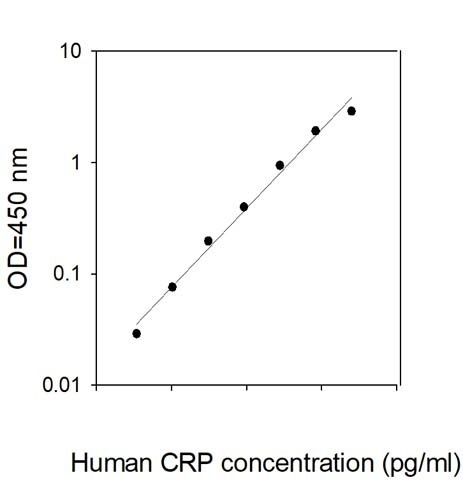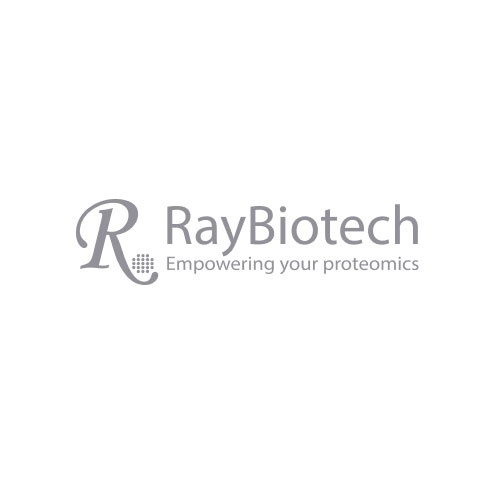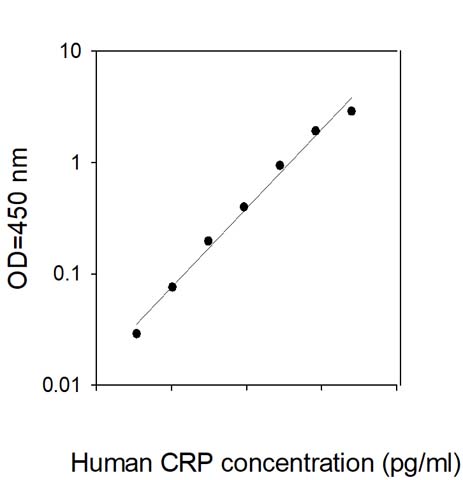RayBio® Human CRP (C-Reactive Protein) ELISA Kit for cell culture supernatants, plasma, and serum samples.
Lead time: Typically ships within 1-2 business days. No Friday shipments.
Product Description
Specifications
| Size | 1 Plate Kit, 2 Plate Kit, 5 Plate Kit |
|---|---|
| Species | Human |
| Accession Number | P02741 |
| Gene Id | 1401 |
| Gene Symbols | CRP|PTX1 |
| Protein Name / Synonyms | C-reactive protein [Cleaved into: C-reactive protein(1-205)] |
| Quantitative/Semi-Quantitative | Quantitative |
| Specificity | This ELISA kit shows no cross-reactivity with the following cytokines tested: human Angiogenin, BDNF, BLC, ENA-78, FGF- 4, IL-1 alpha, IL-1 beta, IL-2, IL-3, IL-4, IL-5, IL-6, IL-7, IL-8, IL-9, IL-10, IL-11, IL-12 p70, IL-12 p40, IL-13, IL-15, I-309, IP-10, GM-CSF, Leptin (OB), MCP-1, MCP-3, MDC, MIP-1 alpha, MIP-1 beta, MIP-1 delta, MMP-1, -2, -3, -10, PARC, RANTES, SCF, TARC, TGF-beta, TIMP-1, TIMP-2, TNF-alpha, TNF-beta, TPO, VEGF. |
| Compatible Sample Types | Cell Culture Supernatants, Plasma, Serum |
| Solid Support | 96-well Microplate |
| Method Of Detection | Colorimetric |
| Design Principle | Sandwich-based |
| Research Area | Cardiovascular Disease |
| Sensitivity | 34 pg/ml Need more sensitivity? Check out the new BIQ-ELISA™ kit for this target. Still not enough? Then your answer is our Ultrasensitive Biomarker Testing Service powered by Simoa™ technology. |
| Detection Range | 34 pg/ml - 25,000 pg/ml |
| Recommended Dilution (Serum/Plasma) | 20,000 fold |
| Estimated Lead Time | 1-2 business days |
| Shipping Type | Blue ice |
| Storage | ≤-20°C |
Risk-Free Guarantee
We offer a 100% guarantee on all ELISA kits and membrane cytokine arrays.
Learn More
Amazon Gift Cards!
$5 Amazon gift card in every kit box purchased.
Verna E., Patel J., Bettencourt R., et al. Novel association between serum pentraxin-2 levels and advanced fibrosis in well-characterised patients with non-alcoholic fatty liver disease. Aliment Pharmacol Ther. 2015 Sep;42(5):582-90. doi: 10.1111/apt.13292.
Species:
Human
Sample Type:
Serum (Advanced Liver Fibrosis in non-alcoholic fatty liner disease)
Smeuninx, Benoit, et al. "Age-related anabolic resistance of myofibrillar protein synthesis is exacerbated in obese inactive individuals." The Journal of Clinical Endocrinology & Metabolism 102.9 (2017): 3535-3545.
Species:
Human
Sample Type:
Plasma (hormone concentration)
Vinayak, Shaveta, et al. "A clinical trial of lovastatin for modification of biomarkers associated with breast cancer risk." Breast cancer research and treatment 142.2 (2013): 389-398.
Species:
Human
Sample Type:
Serum
Zhang L., Wang X., Miao Y., et al. Magnetic ferroferric oxide nanoparticles induce vascular endothelial cell dysfunction and inflammation by disturbing autophagy. J Hazard Mater. 2016 Mar 5;304:186-95. doi: 10.1016/j.jhazmat.2015.10.041
Species:
Human
Sample Type:
Conditioned Media (HUVEC cells treated with various ferroferric oxide nanoparticle comositions)
Duan J, Yu Y, Yu Y, et al. Silica nanoparticles induce autophagy and endothelial dysfunction via the PI3K/Akt/mTOR signaling pathway. International Journal of Nanomedicine 2014;9:5131-5141. doi:10.2147/IJN.S71074.
Species:
Human
Sample Type:
Conditioned Media (HUVEC conditioned media)
Qian Y., Zhang S., Guo W., et al. Polychlorinated biphenyls (PCBs) inhibit hepcidin expression through an estrogen-like effect associated with disordered systemic iron homeostasis. Chem Res Toxicol. 2015 Apr 20;28(4):629-40. doi: 10.1021/tx500428r
Species:
Human
Sample Type:
Conditioned Media (Human hepatocarcinoma cells, HepG2)
Ciaffi L., Cavassini M., Genne D., et al. Switch to etravirine for HIV-positive patients receiving statin treatment: a prospective study. Eur J Clin Invest. 2015 Jul;45(7):720-30. doi: 10.1111/eci.12464.
Species:
Human
Sample Type:
Serum (etravirine treated HIV patients)
Rezvani R., et al. Cross sectional associations of Acylation Stimulating Protein (ASP) and adipose tissue gene expression with estradiol and progesterone in pre and postmenopausal women. Clinical Endocrinology. July 2014. DOI: 10.1111/cen.12540
Species:
Human
Sample Type:
Plasma
Negredo E, Jiménez M, Puig J, Loste C, Pérez-Ãlvarez N, Urrea V, EcheverrÃa P, Bonjoch A, Clotet B, Blanco J. A randomized pilot trial to evaluate the benefit of the concomitant use of atorvastatin and Raltegravir on immunological markers in protease-inhibitor-treated subjects living with HIV. PLoS One. 2020 Sep 17;15(9):e0238575. doi: 10.1371/journal.pone.0238575. PMID: 32941476; PMCID: PMC7498036.
Species:
Human
Sample Type:
Plasma
Priya P., Rajappa M., Kattimani S., et al. Association of neurotrophins, inflammation and stress with suicide risk in young adults. Clin Chim Acta. 2016 Jun 1;457:41-5. doi: 10.1016/j.cca.2016.03.019.
Species:
Human
Sample Type:
Serum (Suicide Risk of at risk patients based on inflammation, stress, and neurotrophins)
Write Your Own Review







